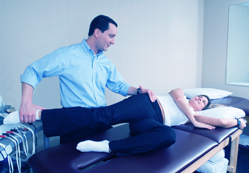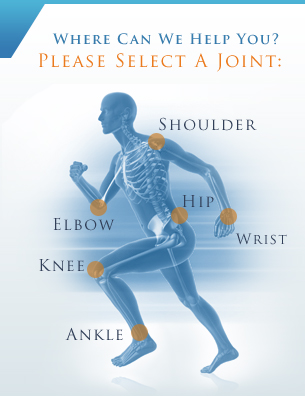
Procedures: Knee
|
|
Meniscus Tear Repair
A torn meniscus is a common injury often caused by forcefully twisting or rotating the knee. It can also be a result of degenerative changes in older adults. A meniscus tear can be repaired through arthroscopic surgery.
How does a meniscus tear happen?
 The menisci are C-shaped pieces of tough cartilage that rest on either side of the knee, between the thigh bone and shin bone. They help to distribute body weight across the knee so it can be properly supported by the bones in the leg, and also provide stability to the knee joint. A meniscus tear is common after a traumatic injury, and most frequently occurs when the knee joint is bent and the knee is then twisted. Torn menisci are common in athletes and older adults whose cartilage may have worn away.
The menisci are C-shaped pieces of tough cartilage that rest on either side of the knee, between the thigh bone and shin bone. They help to distribute body weight across the knee so it can be properly supported by the bones in the leg, and also provide stability to the knee joint. A meniscus tear is common after a traumatic injury, and most frequently occurs when the knee joint is bent and the knee is then twisted. Torn menisci are common in athletes and older adults whose cartilage may have worn away.
A torn meniscus causes pain and swelling, and may also be accompanied by a frequently locking joint and the inability to completely straighten the knee. Some people experience a popping or clicking sensation within the knee as well.
How is a meniscus tear treated?
Treatment for a meniscus tear often begins with conservative methods such as rest, ice or over-the-counter medication. If these treatments are not effective and symptoms continue, you may benefit from meniscus repair surgery. Meniscus repair is an arthroscopic procedure in which the torn segment of the meniscus is removed and the torn edges are sutured together, which allows them to heal properly.
Recovery from meniscus repair surgery can take several months of immobilization and the use of crutches. Most patients recover well from this procedure and are able to return to their normal activities.
Osteoarticular Transfer System (OATS)
The Osteoarticular Transfer System, commonly known as OATS, replaces damaged cartilage in the knee with healthy cartilage from another area of the joint, relieving pain and restoring movement and function to the joint. A mosaicplasty is the name for a general procedure that treats severe cartilage damage, and the OATS procedure is one type of mosaicplasty.
Although cartilage is essential to smooth, painless movement of the joints, some areas have a more critical need for the support and cushioning provided by the cartilage. During the OATS procedure, small plugs of healthy cartilage are removed from areas of the joint that are not in critical need, and transferred to the area of damaged cartilage.
The OATS procedure is ideal for patients with small areas of cartilage damage that can be easily repaired with a graft. Widespread cartilage damage cannot usually be treated with this procedure, since there may be insufficient amounts of healthy cartilage available.
After the OATS procedure, patients will need to undergo a lengthy physical therapy program in order to restore range of motion and relieve pain and swelling on the joint. Most patients will be on crutches for 6 to 12 weeks after surgery before they can successfully bear weight on the joint again. Long-term follow-up care will be required in order to maintain the results of this procedure.
Patellar Instability Treatment
The kneecap (patella) connects the muscles in the thigh to the shinbone. In a healthy knee, the patella rests in a groove in the thighbone and slides up and down as you bend and straighten your leg. Patellar instability, or unstable kneecap, occurs when the patella slips wholly or partially out of the groove. This may occur after an injury or because the groove itself is too shallow or uneven.
If your patella dislocates, you may experience one or more of the following:
- Knee cannot support weight
- Stiffness
- Swelling
- Kneecap slides to the side
- Pain in the front of the knee
- Pain worsens with activity
- Creaking or cracking sounds when moving the knee
If left untreated, patellar dislocation can lead to arthritis, knee instability and chronic knee pain.









